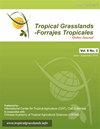10种多年生牧草的生物量和营养品质评价
IF 0.9
4区 农林科学
Q3 AGRICULTURE, DAIRY & ANIMAL SCIENCE
引用次数: 3
摘要
在荷莱塔农业研究中心对4个种的10份多年生饲草材料的牧草干物质产量和营养品质进行了评价。评价的草种和品种为1个德绍草(Pennisetum)品种Kulumsa、4个伞形乌罗草(ILRI-14721、ILRI-14720、ILRI-13205和ILRI-10871)、3个ruziziensis乌罗草(ILRI-14813、ILRI-14774和ILRI-13332)和2个Setaria sphacelata(ILRI-133和ILRI-6543)材料。在建立和生产阶段,随着年份的推移,植株高度和牧草干物质产量受到显著影响。综合分析表明,受试材料的株高差异显著,狗尾草材料比其他受试物种高。综合数据分析表明,牧草干物质产量因品种而异,德绍草(品种Kulumsa)的干物质产量高于其他试验草。纤维含量(NDF、ADF和ADL)受加入量的显著影响。不同材料的粗蛋白产量不同,德绍草的粗蛋白含量较高,其次是U。伞形花序(登录ILRI-13205),U。伞形花序(登录号ILRI-14721)和S。sphacelata(登录号ILRI-6543)。基于干物质产量和粗蛋白U。伞形花序(登录ILRI-13205),U。ruziziensis(登录号ILRI-13332)、S。sphacelata(登录号6543)和Desho草(变种Kulumsa)被推荐为研究区域和类似农业生态的替代牧草。本文章由计算机程序翻译,如有差异,请以英文原文为准。
Evaluation of ten perennial forage grasses for biomass and nutritional quality
A study was carried out to evaluate 10 perennial forage grass accessions from 4 species for herbage dry matter yield and nutritional quality at Holetta Agricultural Research Center. The evaluated grasses species and varieties were one Desho grass (Pennisetum) variety Kulumsa, four Urochloa decumbens (ILRI-14721, ILRI-14720, ILRI-13205 and ILRI-10871), three Urochloa ruziziensis (ILRI-14813, ILRI-14774 and ILRI-13332) and two Setaria sphacelata (ILRI-143 and ILRI-6543) accessions. Plant height and forage dry matter yield were significantly affected by accession over years, during the establishment and production phases. Combined analysis indicated that the tested accessions varied significantly for plant height with the Setaria accessions taller than the other tested species. Combined data analysis revealed that forage dry matter yield significantly varied according to species and Desho grass (variety Kulumsa) was higher in dry matter yield than the other grasses tested. Fiber contents (NDF, ADF and ADL) were significantly influenced by accession. Crude protein yield differed among the accessions and Desho grass had higher crude protein, followed by U. decumbens (accession ILRI-13205), U. decumbens (accession ILRI-14721) and S. sphacelata (accession ILRI-6543). Based on dry matter yield and crude protein U. decumbens (accession ILRI-13205), U. ruziziensis (accession ILRI-13332), S. sphacelata (accession 6543) and Desho grass (var. Kulumsa) are recommended as alternative forage grasses for the study area and similar agro-ecologies.
求助全文
通过发布文献求助,成功后即可免费获取论文全文。
去求助
来源期刊

Tropical Grasslands-Forrajes Tropicales
Agricultural and Biological Sciences-Agronomy and Crop Science
CiteScore
1.60
自引率
0.00%
发文量
36
审稿时长
16 weeks
期刊介绍:
The Journal publishes, in English or Spanish, Research Papers and Short Communications on research and development, as well as contributions from practitioners (Farmer Contributions) and Review Articles, related to pastures and forages in the tropics and subtropics. There is no regional focus; the information published should be of interest to a wide readership, encomprising researchers, academics, students, technicians, development workers and farmers.
In general, the focus of the Journal is more on sown (''improved'') pastures and forages than on rangeland-specific aspects of natural grasslands, but exceptions are possible (e.g. when a submission is relevant for a particularly broad readership in the pasture and forage science community).
The Journal will also consider the occasional publication of associated, but closely related, research in the form of an additional scientific communication platform [e.g. a re-make of the former Genetic Resources Communication series of the former Division of Tropical Crops and Pastures of the Commonwealth Scientific and Industrial Research Organisation (CSIRO), Australia].
Areas of particular interest to the Journal are:
Forage Genetic Resources and Livestock Production[...]
Environmental Functions of Forages[...]
Socio-economic Aspects[...]
Topics within the aforementioned areas may include: Diversity evaluation; Agronomy; Establishment (including fertilization); Management and utilization; Animal production; Nutritive value; Biotic stresses (pests and diseases, weeds); Abiotic stresses (soil fertility, water, temperature); Genetics and breeding; Biogeography and germplasm collections; Seed production; Ecology; Physiology; Rhizobiology (including BNF, BNI, mycorrhizae); Forage conservation; Economics; Multilocational experimentation; Modelling.
 求助内容:
求助内容: 应助结果提醒方式:
应助结果提醒方式:


